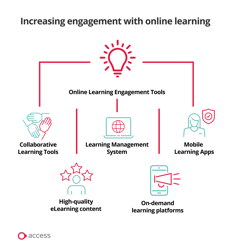How to engage learners in online learning
With remote and hybrid work becoming the norm, and more organisations embracing digital training solutions for their flexibility and scalability, creating engaging online learning activities has become a top priority for learning and development professionals. But while the format offers convenience, it also introduces new challenges, such as how to keep learners genuinely engaged when they’re staring at a screen.
In this article, we’re going to explore how to engage learners in online learning, offering practical strategies, techniques and engagement tools for online learning to keep your learners motivated and eager to learn.
The importance of online learning engagement
Online learning has transformed the way we train our teams. From care workers on the move to office-based teams, the flexibility of a digital approach suits a range of working environments. Not only does it support a self-paced learning style, but it also allows organisations to keep their workforce continually updated with minimal disruption to daily workflows.
That said, engaging employees in online learning can be surprisingly complicated. Unlike in-person training, learners may feel isolated, face technical difficulties, or struggle with motivation, all of which can impact engagement. There are many reasons for a lack of engagement in online learning, and understanding the underlying causes can help you to create engaging online learning activities that promote participation and increase knowledge retention.

Key strategies to increase engagement in online learning
Traditional in-person learning relies on face-to-face interaction, spontaneous discussion and immediate feedback. Online learning lacks these by default, so it’s important to compensate with strategies that tackle digital fatigue, create meaningful interactions, and offer quick wins that keep motivation high.
Let’s explore how to make online training more engaging with some key strategies:
Bitesize learning
Bitesize learning involves delivering content in short, focused bursts. Think micro-lessons that take five minutes rather than forty. This is especially helpful in preventing digital fatigue, as it allows learners to absorb key concepts without feeling overwhelmed. It also aligns with how people tend to consume content online: quickly, casually and in intervals. This makes it easier to build consistent learning habits over time and increase engagement in online learning.
Interactive content
Learners are more likely to engage with online learning content that doesn’t feel like passive information delivery. Interactive modules, like drag-and-drop exercises and gamified elements, mimic the natural engagement you’d expect in a classroom. They encourage decision-making, reflection and curiosity, all of which are key components of deep learning. Gamification, in particular, motivates learners by rewarding progress and encouraging competition in a playful, low-stakes environment.
Online discussions
The absence of casual conversations and peer interaction is one of the biggest gaps in online learning. To simulate the collaborative feel of a classroom, incorporate discussion forums, live chats or breakout groups during webinars and training sessions. These online interactions give learners the opportunity to share perspectives, ask questions and co-construct knowledge to enhance understanding and foster a sense of belonging.
Timely feedback
Feedback is a powerful engagement driver. When learners receive timely feedback, it helps them to understand where they stand and what they can improve. Incorporating elements of reward and recognition for their accomplishments can also significantly boost their motivation and sense of value. Knowing that their efforts are being seen and valued gives them a reason to continue, and instant results from quizzes or interactive tasks can be surprisingly motivating. Many engagement tools for online learning include automated feedback built into the learning system for convenience and quick recapping.
Engaging online learning activities
Beyond strategy, the design of your activities plays a huge role in learner engagement. Activities need to do more than just deliver information; they need to reinforce learning and make the process enjoyable.
1. Interactive quizzes
Quizzes at the end of modules help to test comprehension and give learners instant feedback. This encourages active recall, which is a great technique for boosting knowledge retention. Giving users the option to try again or see explanations for wrong answers reinforces learning and makes it easier to revise topics.
2. Skills assessments
Skills assessments are a useful tool for evaluating progress and identifying skills gaps. Tailored feedback allows learners to focus on specific areas for improvement, making sessions more engaging by increasing their relevance.
3. Group collaboration
The ‘in it together’ feeling of in-person group learning can be transformed into online learning forums or live virtual classrooms to give solitary learning the feeling of a team effort. Working with peers on shared learning goals promotes accountability and adds a social layer to digital training. This is one of the elements that is inherently missing from online learning, so it’s important to proactively introduce these collaborative elements to your L&D strategy.
Engagement tools for online learning
Technology plays a central role in creating engaging learning experiences. There are countless engagement tools for online learning, but a few categories stand out for their ability to spark interest and keep learners coming back.
Learning Management Systems
A Learning Management System (LMS) is the backbone of most online learning programmes. The best LMS platforms do more than just deliver relevant content; they spark a curiosity to learn by offering personal learning journeys, integrated feedback loops and engaging dashboards. Features such as progress tracking, badges and automated reminders and notifications of relevant new learning opportunities help to increase engagement in online learning.
Collaborative learning tools
Tools that support collaboration, such as digital whiteboards and discussion boards, allow learners to co-create and communicate. These platforms enable interactive group work and peer-to-peer support, making learning more social and less isolating. By creating a more dynamic learning experience, collaboration encourages learners to actively get involved.
Mobile learning apps
Smartphone-friendly platforms empower learners to access training on the go, which is ideal for field-based or shift workers. Mobile learning apps are designed with usability in mind, helping learners to dip in and out whenever it suits them. Push notifications, streak tracking and mobile-first designed content with easy scroll and swipe features help to maintain engagement over time and foster consistent learning habits.
High-quality eLearning content
Even the best tools can’t compensate for boring content. To truly engage learners, you need high-quality eLearning modules that are visually appealing, relevant to the learner’s role, and packed with interactive elements. When content is designed with engagement in mind, learners are far more likely to stay focused and complete their training.
On-demand learning platforms
Platforms offering a wide catalogue of on-demand content allow learners to browse and choose topics that interest them. This freedom supports ongoing professional development and encourages exploration beyond mandatory training. With access to everything from bite-sized audio learning in popular podcast styles to detailed eBooks, learners can upskill at their own pace and on their own terms.

How to make online training engaging: strategies to increase engagement in online learning
Before you can make meaningful improvements, it’s important to assess where you are. Having clear goals and the tools to monitor progress are essential steps when creating a strategy of engaging online learning activities.
1. Benchmark online learning engagement
Start by understanding your current engagement levels. Whether that’s completion rates, time spent on digital learning or quiz scores, establishing a benchmark helps you to set realistic goals and track improvements over time.
2. Focus your efforts
Trying to change everything at once can dilute impact. Instead, identify key areas of online learning engagement to focus on. From getting more people to finish their eLearning courses to encouraging more participation in self-directed learning and monitoring rates of content downloads, prioritise a few areas to concentrate your efforts.
3. Invest in suitable learning tools
Choose technologies that support the strategies and activities you want to implement. Whether that’s upgrading your learning management system or introducing higher quality eLearning, invest in engagement tools for online learning that align with your goals and the preferences of your learners.
4. Track online learning engagement
Regular monitoring helps you to see what’s working and what isn’t. Leveraging an AI-powered LMS with sophisticated tracking and reporting capabilities provides reporting dashboards, learner feedback, and engagement analytics. These metrics can give you a clear view of performance and allow you to adapt your approach to make sure your efforts are as successful as possible.
Maximising online training engagement with Access Learning
Keeping learners engaged in an online environment requires more than just uploading content to a platform. It demands a thoughtful approach to learning design, strategic use of technology, and a strong understanding of what motivates people to learn. By focusing on how to engage learners in online learning, and using strategies, activities and tools designed specifically for digital spaces, L&D professionals can create learning experiences that are truly effective.
Our digital learning solutions are built to help you design engaging online learning activities and access the best engagement tools for online learning. Whether you're looking to launch a new programme or increase engagement in online learning across your organisation, we’re here to help.
Get in touch and we’ll be happy to explain how our learning tools can support your goals and offer a free demo so you can see them in action for yourself.

 AU & NZ
AU & NZ
 SG
SG
 MY
MY
 US
US
 IE
IE

